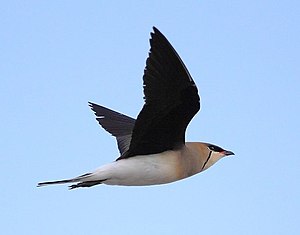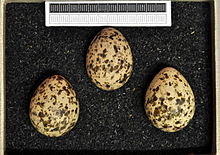Black-winged curlew
| Black-winged curlew | ||||||||||||
|---|---|---|---|---|---|---|---|---|---|---|---|---|

Black-winged curlew ( Glareola nordmanni ) |
||||||||||||
| Systematics | ||||||||||||
|
||||||||||||
| Scientific name | ||||||||||||
| Glareola nordmanni | ||||||||||||
| Fischer , 1842 |

The black-winged curlew ( Glareola nordmanni ) is a species from the subfamily of the curlew-like (Glareolidae). It is a Central Asian breeding bird. In Central Europe it is only a breeding and summer bird in Hungary, in other Central European regions it is not a very frequent stray visitor.
The species name is reminiscent of the Finnish-born zoologist Alexander von Nordmann .
description
The black-winged curlew reaches a body length of 24 to 26 centimeters. Males weigh between 91 and 105 grams, the females are slightly lighter and weigh between 84 and 99 grams. The wingspan is 60 to 68 centimeters.
The black-winged curlew is reminiscent of a large swallow in its shape and flight pattern . It has a long and deeply forked tail and a white rump. On the ground, it is reminiscent of a short-legged, but very long-winged plover, as the wings of the hand clearly protrude above the tail. The top of the body is predominantly dark olive brown. The under wing-coverts are black, the chin and throat cream-colored and set off from the gray-brown breast by a black band. In contrast to the otherwise very similar red-winged curlew , the eye ring is missing. The beak base is red and the beak is short and black.
Fledglings are similar to adult birds. However, they lack the dark throat ligament and the back feathers have large, cream-colored pointy spots.
Distribution area and habitat
The breeding area of the black-winged curlew stretches from Hungary, Romania and the Ukraine to the east of Kazakhstan. It mainly inhabits the steppe zone and can also encompass boreal and desert areas at the edge. The species is a long-distance migrant that overwinters in Africa mostly south of the equator. The migration from the breeding areas takes place from mid-July to mid-September. They move home from April to May.
The habitat of the black-winged curlew are sparsely vegetated open steppe areas. It occurs preferentially near steppe lakes and salt lakes. But it can also be observed on pastures and fields near freshwater.
Way of life
The black-winged curlew mainly eats insects. It hunts mainly in the morning and evening together for swarming flying insects. It also hunts swarms of locusts and termites in the African wintering quarters.
Black-winged curlews probably reach sexual maturity in their first year of life and lead a monogamous seasonal marriage. They breed in colonies that can range from two or three to 200 or 300 breeding pairs. Often they are associated with other species. The nest is a shallow hollow in the ground or a natural depression between loose vegetation. Laying begins at the end of April at the earliest, but mostly in May. The clutch consists of three to four short oval and olive-greenish eggs, which have a dense dark spot. The breeding period is 17 to 19 days and both parent birds are involved in the breeding. The young birds are led by the parent birds for a period of five to six weeks.
Duration
The European population is estimated at 2,500 to 5,100 breeding pairs at the beginning of the 21st century, although the population is declining sharply overall. The European distribution center is in the European part of Russia, the only European area where this species is still a regular breeding bird. There are also up to fifty breeding pairs in Turkey and Ukraine. Individual breeding pairs also occur in Romania and Bulgaria as well as in Hungary.
supporting documents
literature
- Hans-Günther Bauer, Einhard Bezzel , Wolfgang Fiedler (eds.): The compendium of birds in Central Europe: Everything about biology, endangerment and protection. Volume 1: Nonpasseriformes - non-sparrow birds. Aula-Verlag Wiebelsheim, Wiesbaden 2005, ISBN 3-89104-647-2 .
- Peter Colston , Philip Burton: Limicolen - All European wader species, identifiers, flight images, biology, distribution. BlV Verlagsgesellschaft, Munich 1989, ISBN 3-405-13647-4 .
- Simon Delany, Derek Scott, Tim Dodman, David Stroud (Eds.): An Atlas of Wader Populations in Africa and Western Eurasia. Wetlands International , Wageningen 2009, ISBN 978-90-5882-047-1 .
- Gotthelf Fischer von Waldheim: Glareola Nordmannni, fish. (Letter from Mr. von Nordmann to the vice-president of the company) . In: Bulletin de la Société impériale des naturalistes de Moscou . tape 15 , 1842, pp. 314-320 ( biodiversitylibrary.org ).
Single receipts
- ↑ Hans-Günther Bauer, Einhard Bezzel , Wolfgang Fiedler (eds.): The compendium of birds in Central Europe: Everything about biology, endangerment and protection. Volume 1: Nonpasseriformes - non-sparrow birds. Aula-Verlag Wiebelsheim, Wiesbaden 2005, ISBN 3-89104-647-2 , p. 547.
- ^ Gotthelf Fischer von Waldheim (1842), p. 314, plate 2
- ^ Peter Colston, Philip Burton: Limicolen - All European waders species, identifiers, flight images, biology, distribution. BlV Verlagsgesellschaft, Munich 1989, ISBN 3-405-13647-4 , p. 39.
- ↑ Bauer et al., P. 546.
- ↑ Colston et al., P. 41.
- ↑ Bauer et al., Pp. 546-547.
Web links
- Glareola nordmanni inthe IUCN 2013 Red List of Threatened Species . Listed by: BirdLife International, 2012. Retrieved October 8, 2013.
